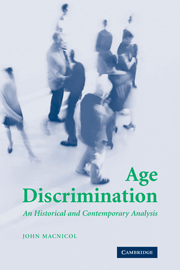Book contents
- Frontmatter
- Contents
- List of figures
- List of tables
- Acknowledgements
- Part I Ageism and Age Discrimination
- Part II The Current Revival of Interest in Britain
- Part III Retirement, health status and work-disability
- Part IV America's Age Discrimination in Employment Act
- 8 The age discrimination debate, from the 1920s to 1967
- 9 From 1967 to the present
- 10 Conclusion
- Bibliography
- Index
8 - The age discrimination debate, from the 1920s to 1967
Published online by Cambridge University Press: 24 August 2009
- Frontmatter
- Contents
- List of figures
- List of tables
- Acknowledgements
- Part I Ageism and Age Discrimination
- Part II The Current Revival of Interest in Britain
- Part III Retirement, health status and work-disability
- Part IV America's Age Discrimination in Employment Act
- 8 The age discrimination debate, from the 1920s to 1967
- 9 From 1967 to the present
- 10 Conclusion
- Bibliography
- Index
Summary
Introduction
In 1967, America passed its historic Age Discrimination in Employment Act (the ADEA). With subsequent amendments, this Act has outlawed age discrimination in employment (with some exceptions) and has abolished mandatory retirement for all but a few stipulated occupations. It stands as the most comprehensive legislative action against age discrimination, and is often referred to in the British debate. This two-chapter section will trace the long-term origins of the Act (going back to the 1920s), including the lively debate on age discrimination and the problems of older workers that took place in the 1950s and 1960s. It will then consider the reasons behind the 1967 Act – itself something of an aberration in a country with far less employment protection than Britain. The operation of the Act from 1967 to the present will then be examined, and its ‘success’ in relation to its notional aims will be evaluated. An examination of the ADEA tells us much about the dilemmas and difficulties of action against age discrimination.
The spread of retirement in the USA
In common with all advanced industrial societies, the United States of America experienced a steady fall in the labour force participation rates of men aged 65+ from the late nineteenth century to the 1990s. Basically, retirement has slowly spread down the age structure. Bearing in mind all the caveats about using census data as an indicator of actual labour force participation, we can see a steady downward trajectory in the labour force participation rates of men aged 65+ between 1890 and 1970 (Table 8.1).
- Type
- Chapter
- Information
- Age DiscriminationAn Historical and Contemporary Analysis, pp. 209 - 233Publisher: Cambridge University PressPrint publication year: 2006



